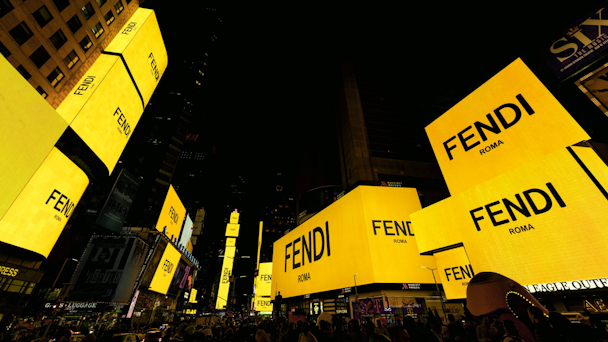Does Fendi’s Times Square takeover prove creativity doesn’t matter?
Fashion brand Fendi last week bathed New York’s Times Square in a welcoming yellow glow in a full out-of-home (OOH) takeover. 45 digital billboards were adopted for a brief but powerful photo op. The Drum asks whether Fendi’s logo bombardment of the iconic site is creative – or not.

Fendi’s out-of-home (OOH) takeover of Times Square
Fendi’s artistic directors Kim Jones, Silvia Venturini Fendi and Delfina Delettrez Fendi took to the streets to enjoy the photo op. Venturini Fendi said: “Times Square is something futuristic, something so different from Rome and peculiar of New York. It’s a landmark of the city – the lights, projection. It’s a window to the future.”
In the aftermath of the Times Square takeover, an interesting debate broke out on Twitter splitting opinion. Was this a creative media buy?
Will Poskett, a consultant who was recently strategy director at Droga5, strongly believes it is “wasteful.” He defines what we mean by creativity in the context of OOH advertising as “the use of imagination to create new or original ideas. The art of being inventive.” The Fendi placement doesn’t tick any of those boxes.
He says: “The idea of doing a ‘city attack’ is not new or original. Campaigns such as The New Museum and Jay Z Decoded are both brilliant examples of city attacks, but with much greater creative flair. Shock horror, they combine a creative media placement with (god forbid) a creative idea.”
Fendi’s placement looks like it was thrown together in PowerPoint, he adds. “No idea. No storytelling. Just a big logo on a background of brand colors. It takes the notion of ‘make the logo bigger’ to the extreme.”
It’s worth remembering that rival fashion house Balenciaga recently ran a Times Square spot with a 3D Fortnite dog – that’s the level of innovation in the industry.
Thom Binding, Essence’s head of creative strategy EMEA, believes the work is an example of “costly signalling” from the Fendi C-suite.
“In order for this particular activation to be considered creative, there needs to be an idea at its core. Otherwise, it is simply plastering distinctive assets and expecting people to understand their purpose.”
But surely the creativity is expressed in the media buy itself, if not the work it is showing?
Binding says his remit at Essence is in making creative contextual at scale. “In digital media we can use all kinds of data to contextualize the work. From environmental factors like location, weather or time of day, to cultural ones like trending content online. There’s a multitude of ways to contextualize creativity.”
But this work is missing a ‘why.’ Media can be implemented creatively, be it Google serving ads against contextual news stories, or Vodafone Turkey servicing domestic violence ads in women-facing media and products. Or the recent wave of 3D billboards we’ve seen.
But one pivotal question is, who was the audience for the spot? Was it those on the street? Or was it a message to the fashion industry that would have seen it on social and several blogs covering the takeover? If cultivated correctly, we know OOH ads can cultivate PR fame, and sometimes that’s their primary objective.
Poskett has an answer for that: “The campaign got little to no traction in the fashion industry. A quick scan of Google News and Google trends shows little pick-up, even in fashion publications. Even on Twitter, there are only a handful of mentions and they are mostly from marketing people, not fashion types.”
The work is big and bold – and invisible, part of the ‘if a tree falls in a forest’ conundrum.
And if in doubt, he believes one should err on the side of creativity. “We know from the seminal work of Binet & Field that creatively awarded campaigns are x11 more efficient at driving share of market growth. Yet as we have discussed this work, by definition, is not creative. It is neither new, original or inventive. It’s simply wasteful.”
Moving to an experienced OOH exec with a contrasting perspective, Keith Nilson, founder of Voodooh, believes the placement is a total win: “It was absolutely perfect for what it actually achieved – total domination of a global landmark.”
Getting the brand color and logo into that space with no other noise or distraction is “utterly inspired.”
He adds: “It works precisely (copywriters worldwide will hate me for it) because it was a simple, total domination, a mass of bright yellow in the heart of a cold New York winter. I’d not change a single thing.”
The image will stick with those who’ve seen it. Did enough people see it, however? To conclude, Binding joked in his thread discussion of the placement that people were attributing the work to Fenty, Fendi and Fenti. Can you remember which one did the stunt?
Runway magazine was also on the scene to capture the moment.

